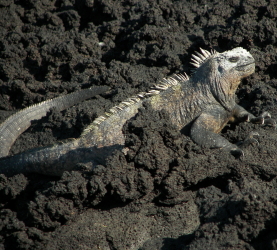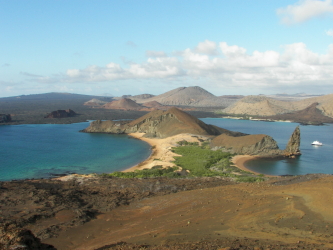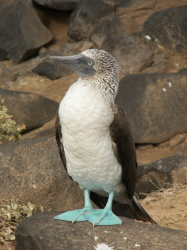|
Santa Cruz has the largest population of the five inhabited islands
of the Galapagos. The town of Puerto Ayora has 15,000 residents
and is home to the national park headquarters and the Charles Darwin
Research Center. One of the interesting laws in Equador is that
citizens are required to vote. When they do, they get a card certifying
that they voted. If a person does not have a card, they can not
buy land, get a passport, get a loan, etc.
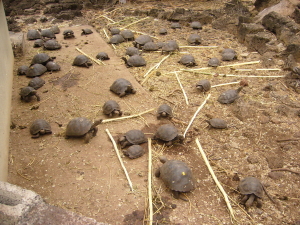 Our
first stop on Santa Cruz was the Darwin Research Center. Though
primarily an international scientific research station, it is one
of the most visited spots on the islands. There is a tortoise raising
center in an effort to replace the population of tortoises that
were destroyed during the whaling days (see Tortoise
Photo Gallery for more information and photos of the Giant Tortoise).
Tortoise eggs are retrieved and tagged with the island they were
from. At 5 years old, the tortoises are released back on the same
island. The temperature of the eggs determines the sex of the tortoise,
females require warmer incubation. Our
first stop on Santa Cruz was the Darwin Research Center. Though
primarily an international scientific research station, it is one
of the most visited spots on the islands. There is a tortoise raising
center in an effort to replace the population of tortoises that
were destroyed during the whaling days (see Tortoise
Photo Gallery for more information and photos of the Giant Tortoise).
Tortoise eggs are retrieved and tagged with the island they were
from. At 5 years old, the tortoises are released back on the same
island. The temperature of the eggs determines the sex of the tortoise,
females require warmer incubation. 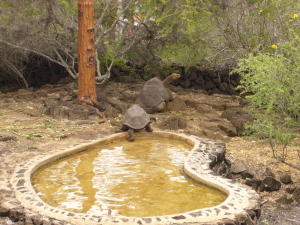 The
most famous occupant in the research center is Lonesome George.
He is the last tortoise of his species from Pinta Island and researchers
are trying to get him to breed with females of a sub-species close
to his. But so far, nothing has worked. At over 80 years old, he
just doesn't seem to be interested! The
most famous occupant in the research center is Lonesome George.
He is the last tortoise of his species from Pinta Island and researchers
are trying to get him to breed with females of a sub-species close
to his. But so far, nothing has worked. At over 80 years old, he
just doesn't seem to be interested!
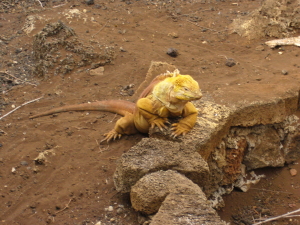 The
station also has a couple of land iguanas. The
station also has a couple of land iguanas.
We walked back to town from the Research Station, stopping at the
t-shirt, art and other colorful souvenir shops along the way. It
was the only time we had rain during our entire visit in the Galapagos.
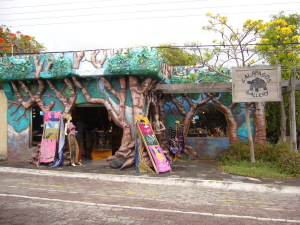
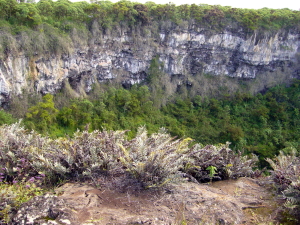 From
town, we boarded a bus up to the cool, moist highlands of Santa
Cruz, a lush green landscape very different from anything we have
seen so far. After a nice barbecue lunch at a private home and restaurant,
Altair, we drove up to see two huge pit craters called Los Gemelos.This
is an eroded volcano cone that is covered in vegetation. There were
many unique plants around the crater with long latin botanical names! From
town, we boarded a bus up to the cool, moist highlands of Santa
Cruz, a lush green landscape very different from anything we have
seen so far. After a nice barbecue lunch at a private home and restaurant,
Altair, we drove up to see two huge pit craters called Los Gemelos.This
is an eroded volcano cone that is covered in vegetation. There were
many unique plants around the crater with long latin botanical names!
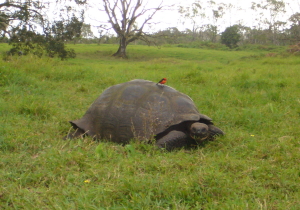 Further
down in the highlands, we visited a ranch which the Giant Tortoises
use as a migratory route this time of year to feed on the lush grasses
and luxuriate in seasonal pools. The Polaris supplied us each with
rubber boots as we had to tromp across the open pastures thru high
grass and muddy fields (which were also full of Tortoise poop!).
The highlight for all us photographers was a tortoise with a bright
red Vermillion Flycatcher perched on his shell. We saw tortoises
slowly making their way through the field, happily munching away,
and others wallowing in a duckweed pond. Further
down in the highlands, we visited a ranch which the Giant Tortoises
use as a migratory route this time of year to feed on the lush grasses
and luxuriate in seasonal pools. The Polaris supplied us each with
rubber boots as we had to tromp across the open pastures thru high
grass and muddy fields (which were also full of Tortoise poop!).
The highlight for all us photographers was a tortoise with a bright
red Vermillion Flycatcher perched on his shell. We saw tortoises
slowly making their way through the field, happily munching away,
and others wallowing in a duckweed pond.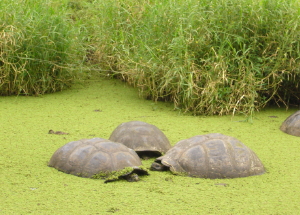
After dinner, local musicians came on board and entertained us
with Ecuadorian music and dance.
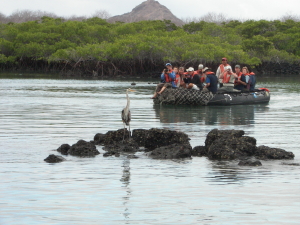 The
next day it was an early morning (5:30) wake up for the photographers
to take zodiaks around Venecia Islet. After breakfast, we went back
in kayaks for a wonderful paddle around the lagoon. Saw pelicans,
great blue herons, marine iguanas, blue footed boobies and flightless
cormorants. The
next day it was an early morning (5:30) wake up for the photographers
to take zodiaks around Venecia Islet. After breakfast, we went back
in kayaks for a wonderful paddle around the lagoon. Saw pelicans,
great blue herons, marine iguanas, blue footed boobies and flightless
cormorants.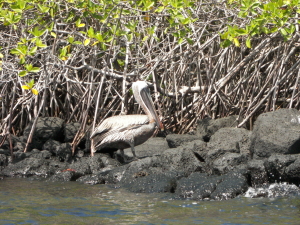
Back on board, one of the naturalists gave an excellent presentation
on of the life of Charles Darwin. One of the most interesting facts
we learned was that he only visited 4 islands and he was seasick
during most of his journey to the Galapagos.
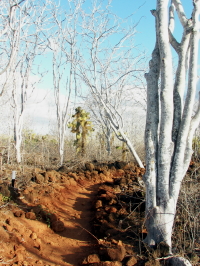 Later
in the afternoon we went for a walk around Cerro Dragon, which has
historically been the home of the famed, endemic Galapagos land
iguanas. The population was almost wiped out by feral dogs in the
sixties, however a hugely successful captive breeding program has
allowed the population to recover. We saw a couple as they stuck
their head out of their burrows. Later
in the afternoon we went for a walk around Cerro Dragon, which has
historically been the home of the famed, endemic Galapagos land
iguanas. The population was almost wiped out by feral dogs in the
sixties, however a hugely successful captive breeding program has
allowed the population to recover. We saw a couple as they stuck
their head out of their burrows.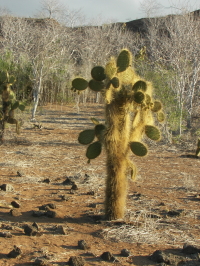 This part of the island has some forests of the giant prickly pear
cactus which glowed in the late day light. They are a favorite food
for the land iguanas.
This part of the island has some forests of the giant prickly pear
cactus which glowed in the late day light. They are a favorite food
for the land iguanas.
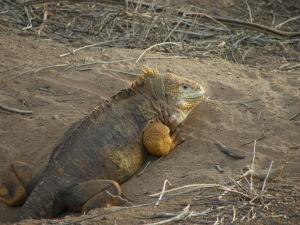 Tonights
coctail was a land iguana - rum and pinapple juice mixture. After
dinner, those with laptops set up a rolling slide show of their
best photos. Tonights
coctail was a land iguana - rum and pinapple juice mixture. After
dinner, those with laptops set up a rolling slide show of their
best photos.
Home Journals
Photos Map
Contact Us
|
